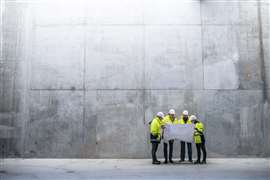Read this article in Français Deutsch Italiano Português Español
EU Pay Transparency Directive: what will it mean for international construction businesses?
28 October 2025
 European Parliament building in Brussels (Image: Grecaud Paul via AdobeStock - stock.adobe.com)
European Parliament building in Brussels (Image: Grecaud Paul via AdobeStock - stock.adobe.com)
With less than a year to go until the European Union’s (EU) Pay Transparency Directive takes effect, what does it mean for international construction businesses?
Louise Skinner, partner in the London office of global law firm Morgan Lewis, and associates Aaron Grant and Phoebe Fardell explain.
With less than one year to go until the EU Pay Transparency Directive (the ‘Directive’) takes effect in June 2026, organisations employing workers in the European Union should prepare for new obligations focused on the principle of equal pay for equal work or work of equal value between men and women.
The Directive introduces a comprehensive framework of pay transparency measures and reporting requirements that warrant proactive attention from employers of all sizes, even where pay gap reporting headcount thresholds are not met. The Directive will have significant implications for employers in the construction industry, which is typically heavily dominated by male workers, meaning the principle of pay transparency will be particularly important for the development of balanced pay practices and career progression in the industry.
Member States that have taken substantive steps towards implementing the Directive currently include Belgium, Czech Republic, Finland, France, Ireland, Lithuania, Malta, the Netherlands, Poland and Sweden. Significantly, some of these government’s proposals and/or legislation refer to obligations coming into force sooner than the June 2026 implementation deadline referred to in the Directive.
Key requirements of the Directive
To comply with the Directive, employers should be aware of the following key obligations designed to promote pay transparency:
- Equal work and work of equal value: Member States must ensure that employers implement pay structures that guarantee equal pay for equal work or work of equal value, supported by accessible analytical tools, methodologies and structures designed to help assess and objectively compare the value of work, based on gender-neutral criteria.
- Rights to information: Employers of all sizes must be prepared to provide all workers with written information, upon request, about their individual pay and the average pay levels, broken down by sex, for comparable work or work of equal value. Employers must annually inform workers of this right and respond to a request within two months. Workers can request further clarification if the information is inaccurate or incomplete, and they are entitled to these additional details and a substantiated response. This obligation is crucial for employers to consider because it requires every employer, even those not subject to formal reporting requirements, to carry out analysis of pay levels in order to provide accurate and meaningful pay information.
- Gender Pay Reporting: Employers must provide information regarding the mean and median gender pay gaps, including: (a) those based on complementary and variable pay components (such as bonuses), (b) the proportion of men and women receiving these pay components, (c) the gender distribution within each pay quartile and (d) pay gaps across worker categories broken down by basic salary and complementary or variable pay. (a) – (c) must be reported to the relevant authority and shall be made publicly available. (d) must be provided to workers and workers’ representatives, as well as the labour inspectorate and the equality body upon request. The accuracy of the reported information and methodologies used must be shared and verified in consultation with workers’ representatives. The thresholds are as follows: 1) Employers with 100-149 employees: Must publish the report by 7 June 2031 and every three years after; 2) Employers with 150-249 employees: Must publish the report by 7 June 2027 and every three years after; 3) Employers with >250 employees: Must publish the report by 7 June 2027 and annually.
- Joint pay assessments: Employers subject to the reporting obligation must conduct a joint pay assessment if their report shows a gender pay gap of 5% or more in any worker category that cannot be justified by objective, gender-neutral criteria and remains unaddressed six months after reporting. This assessment must include a prescribed analysis and be shared with workers, representatives, and monitoring bodies. Additionally, employers are required to remedy unjustified pay differences promptly in cooperation with workers’ representatives, with possible involvement from the labour inspectorate and equality body.
UK / EU divergence
The Directive currently goes considerably further than any existing UK pay reporting obligations. However, the UK government has recently issued a call for evidence seeking opinions on whether introducing legally binding pay transparency measures would be a proportionate and effective way to improve pay equality in the UK.
The government’s suggestions mirror some aspects of the Directive. The future UK measures could include requiring employers to provide specific salary ranges in job advertisements before interviews and a prohibition on enquiring as to a candidate’s salary history. It is a case of watch this space in the UK.
Implications for employers
The Directive introduces significant new obligations that will impact employers operating in the EU, especially those with populations in countries with limited existing pay transparency requirements. The non-gender pay reporting obligations under the Directive will apply irrespective of headcount, and worker’s rights to information regarding their own pay levels and the average pay levels for categories of workers performing the same work as them or work of equal value to theirs means that some form of analysis will be required for those employers to whom the reporting obligations do not apply, in order to obtain the necessary data to comply with such requests.
The Directive will likely influence what is perceived as best practice, resulting in an increased volume of work for employers as they take steps to implement the administrative framework required under the Directive (for example, training staff or updating and adapting pay related policies). There is also the potential for a significant economic impact if employers do not comply with the Directive, as they may be faced with significant fines and a requirement to take corrective action.
Implementation of the Directive is also expected to result in an increase in pay equity litigation, as seen in recent high-profile cases in countries including Belgium, France, and the UK, where access to pay data was crucial for the claimants’ cases. To prepare, employers should proactively review their pay structures, ensure accurate data collection, and be ready to respond effectively to both information requests and potential legal challenges.
What is the impact specifically for employers in the construction industry?
Many employers in the construction industry are known to have active worker representatives in place through works councils and trade unions, and in many cases collective bargaining agreements are in place to regulate levels of pay. Employers in the construction industry should carefully consider the impact of such agreements or arrangements when preparing to comply with the Directive and should ensure that any existing worker representatives are informed about the employer’s proposed approach to implementation.
In addition, as the construction industry has a high proportion of male workers, the assessment of work of equal value will be key to ensuring that pay practices are fair and unbiased. Further, as there are typically fewer women in more senior roles within the industry, this could result in higher overall pay gaps, making communication with employees particularly important..
What should employers do now?
With the deadline for implementation of the Directive fast approaching, organisations operating within the EU should begin preparing. For employers likely to fall within the scope of the gender pay reporting obligations, given that there is only one full annual payroll cycle remaining before the Directive comes into effect, now is the time to conduct a trial run of the reporting process to identify and address any potential pay gaps or areas of concern.
- Proactive steps which can be taken by all employers now to prepare ahead of the implementation date, and before each Member State has transposed the Directive into national law include:
- Establish a shared internal understanding of “equal work” and “work of equal value”, and begin mapping roles into comparable groups that go beyond seniority levels or reporting structures to align with the Directive’s expectations.
- Audit current pay policies, job evaluation systems, job descriptions, and recruitment materials to ensure they are gender-neutral and based on objective, transparent criteria.
- Review and update employment contract templates to remove clauses that restrict pay transparency, such as pay secrecy provisions.
- Develop clear internal policies and procedures outlining how the organisation will respond to employee requests for pay information under the new information rights.
- Assess the capabilities of payroll systems and job classification structures, ensuring they are detailed enough to support accurate and compliant reporting.
Employers should also consider establishing a legally privileged framework under which to seek advice and assess relevant risks as they prepare for compliance with the Directive.
By taking these steps now, employers will be better positioned to comply with the Directive, reduce the risk of non-compliance, and demonstrate a strong commitment to pay equity and transparency across their EU operations.
STAY CONNECTED


Receive the information you need when you need it through our world-leading magazines, newsletters and daily briefings.
CONNECT WITH THE TEAM










